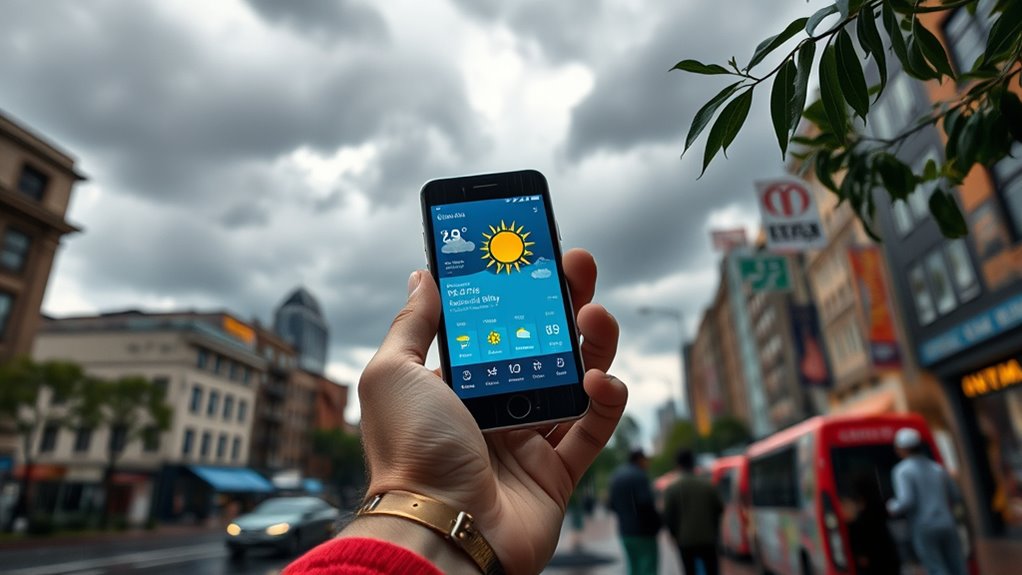Weather apps are helpful tools, but they can’t guarantee perfect accuracy because weather is complex and unpredictable. Small atmospheric changes can cause surprises, and models rely on data that can’t capture every local detail. You should use forecasts as guides, not certainties, and stay alert to updates. By understanding these limitations, you can better navigate weather surprises — and if you keep exploring, you’ll learn how to plan more confidently.
Key Takeaways
- Weather apps provide general forecasts, but local microclimates and sudden changes often differ from predictions.
- Forecasts are educated estimates based on complex models, not guaranteed or exact outcomes.
- Using multiple sources and real-time observations improves accuracy over relying solely on weather apps.
- Short-term and local weather phenomena, like brief thunderstorms, may not appear in forecasts.
- Stay adaptable and prepared for surprises, as weather prediction models cannot capture all atmospheric variables.

Weather apps promise to keep you ahead of the storm, but their forecasts often fall short of real-world conditions. You’ve probably experienced checking your favorite app in the morning, only to find the weather drastically different when you step outside. That’s because weather prediction isn’t an exact science. These apps rely on complex models and data from satellites, weather stations, and atmospheric sensors. While they do a good job at giving general trends, they can’t always predict local variations or sudden changes. You might see a forecast calling for clear skies, but then encounter unexpected rain because the models missed a small but notable atmospheric shift. It’s frustrating, especially when you’ve planned your day around the forecast.
One reason for this disconnect is that weather models are inherently imperfect. They process enormous amounts of data, but the atmosphere is incredibly complex and chaotic. Small differences in initial data can lead to big discrepancies in predictions. Apps tend to favor the most probable scenario, but that doesn’t mean it will always match what actually happens. For example, a forecast might say there’s a 20% chance of rain, but if you’re in that 20%, chances are high you’ll see rain, even if the app didn’t predict it. Conversely, sometimes the app predicts rain, but it stays dry where you are. These inaccuracies are part of the nature of weather forecasting. Additionally, model limitations mean that even the most advanced tools cannot perfectly simulate atmospheric behavior.
Another factor to contemplate is that weather apps are designed for general use. They give you a broad overview, but they can’t account for microclimates or local environmental factors. If you live in a hilly area or near a large body of water, your weather could differ markedly from the forecast. Apps often use radar and localized data to improve accuracy, but they can still miss small-scale phenomena like brief thunderstorms or sudden fog. This means you need to take their predictions with a grain of salt and be prepared for surprises.
Ultimately, the best approach is to use weather apps as a helpful guide rather than a definitive answer. Check multiple sources, stay alert for updates, and pay attention to local weather reports if you’re planning outdoor activities. Recognize that forecasts are educated guesses based on current data and models, not crystal balls. When you understand their limitations, you can better navigate the unpredictable nature of weather and avoid being caught off guard. In the end, your own observation and flexibility are the most reliable tools to stay safe and prepared.
Frequently Asked Questions
How Often Do Weather Apps Update Their Forecasts?
Weather apps typically update their forecasts every hour or two, especially for short-term predictions. Some apps refresh more frequently, especially during rapidly changing weather conditions. However, the accuracy of these updates depends on the data sources and the app’s algorithms. You should check the update timestamp to verify you’re seeing the latest forecast. Keep in mind, forecasts become less reliable as they extend beyond a few days.
Can Weather Apps Predict Extreme Weather Events Accurately?
Weather apps can’t always predict extreme weather events accurately. They use models that sometimes miss sudden changes or rare phenomena. While they’re good at forecasting general conditions, you should stay alert for warnings from official sources during severe weather. Trust your app for quick updates, but always follow local alerts and emergency advice to stay safe during extreme events. Don’t rely solely on your app for life-threatening situations.
Do Weather Apps Consider Microclimates in Their Forecasts?
Weather apps often don’t fully consider microclimates in their forecasts. They rely on broader regional data, which can miss local variations caused by terrain, urban heat islands, or bodies of water. If you live in an area with distinct microclimates, you might notice your app’s predictions aren’t always spot-on. To get the most accurate info, check local weather stations or hyperlocal forecasts for better insights into your specific area.
How Do Weather Apps Gather Their Data Sources?
You might think weather apps pull their data out of thin air, but they actually gather info from multiple sources. They use weather satellites, radar, ground stations, and computer models to get a full picture. This way, they can provide relatively accurate forecasts. Keep in mind, though, that they can’t capture every microclimate detail, so sometimes, the weather might surprise you despite all their data.
Are Paid Weather Apps More Reliable Than Free Ones?
Paid weather apps tend to be more reliable because they often use advanced technology and receive more frequent updates, giving you more accurate forecasts. Free apps can be useful, but they might rely on less detailed data or update less often. If you need precise weather info for planning or safety, investing in a paid app can be worth it. Just make sure to choose one with good reviews and solid data sources.
Conclusion
So, next time you check your weather app before heading out, remember it’s a helpful guide but not perfect. Imagine planning a picnic based on a sunny forecast, only to get caught in rain because the app missed the sudden storm. Trust it as a tool, but stay flexible. Weather can surprise you—so keep an eye on updates and be ready for anything. Your plans, and your day, will thank you.










